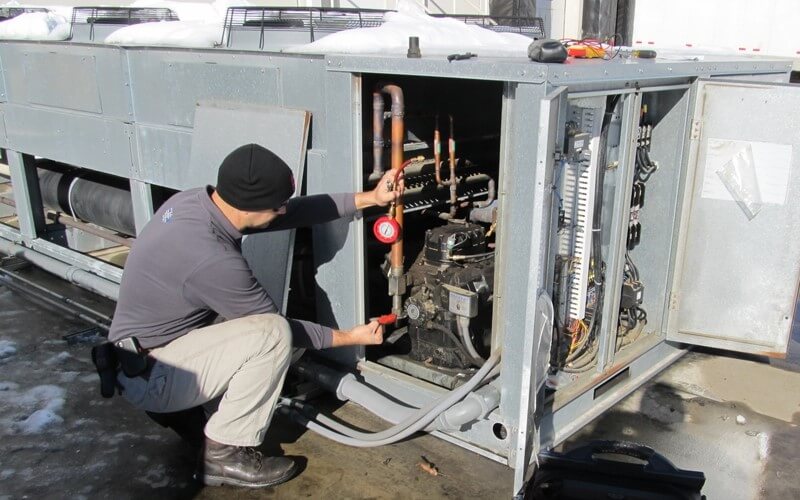Is your standing chiller failing to maintain proper cooling temperatures? Perhaps your products are spoiling faster than usual, or the unit is running constantly without achieving adequate coldness. These aggravating situations plague many business owners who depend on commercial refrigeration daily.
Standing chillers are essential for restaurants, grocery stores, and food service operations. When they malfunction, your inventory and reputation suffer immediately. This comprehensive guide explores typical chiller problems and explains why professional intervention becomes necessary for reliable solutions.
Identifying Common Standing Chiller Failures
Temperature Maintenance Issues
Your chiller’s thermostat shows the desired setting, yet products inside remain warmer than they should be. This temperature inconsistency signals underlying cooling system problems affecting food preservation.
Refrigerant leaks gradually reduce cooling capacity over time. Small leaks worsen progressively, causing the compressor to work harder without achieving proper temperatures.
Faulty thermostat sensors fail to accurately measure internal temperatures. When sensors malfunction, the cooling cycle either runs excessively or stops prematurely, preventing temperature stability.
Evaporator coil icing prevents proper air circulation inside the chiller cabinet. Accumulated frost blocks cold air distribution, leaving certain areas warm while others freeze.
Compressor wear reduces the unit’s ability to compress refrigerant effectively. Aging compressors eventually lose efficiency despite running continuously throughout the day.
Refrigeration Component Deterioration
Your standing chiller makes unusual grinding or rattling sounds that weren’t present initially. These mechanical noises indicate serious internal component damage requiring immediate professional assessment.
Standing Chiller Repair specialists commonly encounter worn compressor bearings that create grinding sounds. These critical components support the compressor shaft and eventually deteriorate from constant operation.
Condenser coil blockages restrict refrigerant flow through the cooling system. Dust, debris, and grease accumulation on exterior condenser fins prevent effective heat release.
Expansion valve failures disrupt the refrigerant flow cycle. When these valves malfunction, refrigerant either bypasses the evaporator or flows too slowly, disrupting temperature control.
Motor coupling damage prevents proper power transfer from the motor to the compressor. Broken couplings are common in heavily used commercial chillers operating around the clock.
Condensation and Drainage Complications
Water pools inside your standing chiller or drips onto your kitchen floor unexpectedly. These drainage failures create safety hazards and indicate internal system problems.
Clogged drain tubes prevent condensation water from exiting the chiller properly. Mineral deposits and bacterial growth restrict water movement through drainage pathways gradually.
Faulty drain pump motors lose their effectiveness over extended periods. These pumps wear out from continuous operation in harsh commercial kitchen environments.
Damaged door seals allow warm air infiltration while preventing proper moisture removal. Worn gaskets compromise the chiller’s ability to maintain internal humidity levels.
Why Professional Support Matters
Specialized Technical Knowledge
Commercial chillers operate using complex refrigeration principles that require deep technical understanding. Diagnosing problems accurately demands expertise in mechanical and electrical systems working together.
Standing Chiller Repair demands familiarity with various commercial brands and their unique design specifications. Each manufacturer engineers their units differently, requiring specific diagnostic approaches.
Refrigerant handling requires proper licensing and certification according to environmental regulations. Improper refrigerant management creates legal liability and environmental damage.
Electrical components in commercial chillers carry significant voltage requiring specialized safety protocols. Untrained technicians risk electrocution when working on these powerful systems.
Protecting Business Operations
Food service businesses lose revenue during chiller downtime when products spoil and service interruptions occur. Professional repairs minimize downtime and restore functionality quickly.
Professional technicians carry commercial-grade tools specifically designed for heavy-duty equipment repair. Proper equipment prevents damage and ensures lasting repairs completed correctly.
Warranty protection remains valid when authorized service providers handle repairs. DIY attempts immediately void manufacturer coverage, leaving you financially exposed.
Preventing Escalated Damage
Delaying repairs on commercial chillers allows minor problems to become major failures. Early professional intervention prevents expensive compressor replacement or complete unit breakdown.
Quality diagnostics identify root causes rather than treating symptoms. This prevents recurring problems that waste money on repeated repairs.
Professional repairs use genuine commercial-grade parts built for heavy daily operation. Substandard replacement parts fail prematurely, creating additional service interruptions.
Selecting Dependable Repair Services
Essential Qualifications to Verify
Choose companies with extensive experience in commercial refrigeration systems. General appliance repair knowledge doesn’t translate to specialized chiller expertise.
EPA certification indicates proper refrigerant handling and environmental compliance knowledge. Certified technicians meet legal requirements for commercial refrigeration work.
Valid commercial licensing and comprehensive liability insurance protect your business legally. These credentials demonstrate accountability and professional standards.
Same-day or emergency response availability matters for critical chiller failures. Reliable services prioritize urgent commercial calls to minimize your operational losses.
Important Questions to Ask Technicians
Inquire about their specific experience with your chiller brand and model. Familiarity ensures faster diagnosis and more accurate problem identification.
Ask about their diagnostic procedures and associated service call fees. Understanding fee structures prevents unexpected charges in your repair bills.
Request details about parts sourcing and quality standards. Commercial-grade genuine parts typically cost more but provide superior reliability.
Ask about extended warranties and service contracts. Regular maintenance plans prevent emergency failures and extend chiller lifespan significantly.
Preventive Maintenance Strategies
Regular Cleaning Protocols
Clean condenser coils monthly to maintain efficient heat release. Dust and debris accumulation significantly reduces cooling performance over time.
Inspect and clean drain tubes quarterly to prevent blockages. Regular maintenance prevents water backup and interior flooding issues.
Check door seals regularly for visible wear or damage. Replace deteriorating gaskets immediately to maintain proper temperature and humidity control.
Monitor refrigerant levels monthly as part of routine maintenance checks. Low refrigerant levels indicate potential leaks requiring professional attention.
Operational Best Practices
Avoid overloading your chiller beyond its designed capacity limits. Excessive inventory stresses cooling systems and accelerates component wear.
Maintain surrounding area ventilation for proper airflow around the chiller unit. Restricted airflow reduces condenser efficiency significantly.
Keep emergency service numbers readily available for quick response during urgent situations. Prepared planning minimizes downtime during critical failures.
Schedule annual professional inspections to catch emerging problems early. Preventive maintenance extends equipment lifespan and reduces repair frequency.
Frequently Asked Questions
How quickly can standing chiller repairs be completed?
Most repairs finish within 2-4 hours depending on problem complexity and parts availability. Simple fixes like gasket replacement take less time than compressor or motor repairs requiring component replacement.
What is the typical cost for standing chiller repairs?
Repair costs generally range from AED 400 to AED 2,500 depending on the issue and required parts. Minor repairs cost less while compressor or electrical system repairs are more expensive.
Should I repair or replace my standing chiller?
If repair costs are less than 50% of replacement value and your chiller is under 10 years old, repair usually makes economic sense. Consider the unit’s overall condition and repair history before deciding.
Can my chiller continue operating during diagnosis?
Limited operation is sometimes possible for minor issues, but serious problems like refrigerant leaks or compressor damage require immediate shutdown to prevent further damage.
How often do commercial chillers require professional maintenance?
Quarterly professional inspections help identify problems early and maintain peak performance. Regular maintenance extends equipment lifespan significantly and prevents unexpected breakdowns.
Taking Action
When your standing chiller develops problems, professional diagnosis ensures accurate identification and reliable solutions. Understanding your repair options helps you make informed decisions protecting your business operations.
Quality repair services combine deep technical expertise with commitment to minimizing your business disruption, delivering repairs that restore full functionality safely and efficiently.



